An Assessment of Wind Energy Potential for the Three Topographic Regions of Eritrea
Abstract
1. Introduction
2. Theory
3. Method and Observations
3.1. Measurement Series
3.2. Potential Sites for Wind Farms in Eritrea
4. Results and Discussion
5. Conclusions
Author Contributions
Funding
Acknowledgments
Conflicts of Interest
References
- Kaldellis, J.K.; Zafirakis, D. The wind energy (r) evolution: A short review of a long history. Renew. Energy 2011, 36, 1887–1901. [Google Scholar] [CrossRef]
- Möllerström, E.; Gipe, P.; Beurskens, J.; Ottermo, F. A historical review of installed vertical axis wind turbines rated 100 kW and above. Renew. Sustain. Energy Rev. 2019, 105, 1–13. [Google Scholar] [CrossRef]
- Möllerström, E. Wind Turbines from the Swedish Wind Energy Program and the Subsequent Commercialization Attempts—A Historical Review. Energies 2019, 12, 690. [Google Scholar] [CrossRef]
- GWEC Global Wind Report 2018; Global Wind Energy Council: Brussels, Belgium, 2018.
- World Energy Outlook 2018; International Energy Agency (IEA): Paris, France, 2018; Available online: https://www.iea.org/reports/world-energy-outlook-2018 (accessed on 9 April 2020).
- Mukasa, A.D.; Mutambatsere, E.; Arvanitis, Y.; Triki, T. Development of Wind Energy in Africa; Working Paper Series; No 170; African Development Bank Group: Tunis, Tunisia, March 2013. [Google Scholar]
- Mulugetta, Y.; Drake, F. Assessment of solar and wind energy resources in Ethiopia. II. Wind energy. Sol. Energy 1996, 57, 323–334. [Google Scholar] [CrossRef]
- Drake, F.; Mulugetta, Y. Assessment of solar and wind energy resources in Ethiopia. I. Solar energy. Sol. Energy 1996, 57, 205–217. [Google Scholar] [CrossRef]
- Rosen, K.; Van Buskirk, R.; Garbesi, K. Wind energy potential of coastal Eritrea: An analysis of sparse wind data. Sol. Energy 1999, 66, 201–213. [Google Scholar] [CrossRef]
- Van Buskirk, R.; Garbesi, K.; Rosen, K. Wind resource assessment of Eritrea, Africa: Preliminary results and status. J. Wind Eng. Ind. Aerodyn. 1998, 74, 365–374. [Google Scholar] [CrossRef]
- Mentis, D.; Hermann, S.; Howells, M.; Welsch, M.; Siyal, S.H. Assessing the technical wind energy potential in Africa a GIS-based approach. Renew. Energy 2015, 83, 110–125. [Google Scholar] [CrossRef]
- Langodan, S.; Viswanadhapalli, Y.; Dasari, H.P.; Knio, O.; Hoteit, I. A high-resolution assessment of wind and wave energy potentials in the Red Sea. Appl. Energy 2016, 181, 244–255. [Google Scholar] [CrossRef]
- Habtetsion, S.; Tsighe, Z. Energy sector reform in Eritrea: Initiatives and implications. J. Clean. Prod. 2007, 15, 178–189. [Google Scholar] [CrossRef]
- Wisse, J.A.; Stigter, C.J. Wind engineering in Africa. J. Wind Eng. Ind. Aerodyn. 2007, 95, 908–927. [Google Scholar] [CrossRef]
- Manwell, J.F.; McGowan, J.G.; Rogers, A.L. Wind Energy Explained: Theory, Design and Application; Wiley: Chichester, UK, 2010. [Google Scholar]
- Seguro, J.; Lambert, T. Modern estimation of the parameters of the Weibull wind speed distribution for wind energy analysis. J. Wind Eng. Ind. Aerodyn. 2000, 85, 75–84. [Google Scholar] [CrossRef]
- Floors, R.; Nielsen, M.J.E. Estimating Air Density Using Observations and Re-Analysis Outputs for Wind Energy Purposes. Energies 2019, 12, 2038. [Google Scholar] [CrossRef]
- Solomon, K. Wind and Solar Monitoring Network Summary Report (Internal Report); Ministry of Energy and Mines, Department of Energy ERTC: Asmara, Eritrea, 2006. [Google Scholar]
- Langodan, S.; Cavaleri, L.; Vishwanadhapalli, Y.; Pomaro, A.; Bertotti, L.; Hoteit, I. The climatology of the Red Sea–part 1: The wind. Int. J. Clim. 2017, 37, 4509–4517. [Google Scholar] [CrossRef]
- Tesfagiorgis, M.G. Eritrea; ABC-CLIO: Santa Barbara, CA, USA, 2010. [Google Scholar]
- Global Wind Atlas v.3.0. Available online: https://globalwindatlas.info/ (accessed on 30 October 2019).
- Ragnarsson, B.; Oddsson, G.; Unnthorsson, R.; Hrafnkelsson, B.J.E. Levelized cost of energy analysis of a wind power generation system at burfell in iceland. Energies 2015, 8, 9464–9485. [Google Scholar] [CrossRef]
- Gallo, P.; Fredianelli, L.; Palazzuoli, D.; Licitra, G.; Fidecaro, F. A procedure for the assessment of wind turbine noise. Appl. Acoust. 2016, 114, 213–217. [Google Scholar] [CrossRef]
- Fredianelli, L.; Gallo, P.; Licitra, G.; Carpita, S. Analytical assessment of wind turbine noise impact at receiver by means of residual noise determination without the wind farm shutdown. Noise Control. Eng. J. 2017, 65, 417–433. [Google Scholar] [CrossRef]
- Yamanidouzisorkhabi, S.; Romero, D.; Yan, G.K.; Gu, M.D.; Moran, J.E.; Morgenroth, M.; Amon, C. The impact of land use constraints in multi-objective energy-noise wind farm layout optimization. Renew. Energy 2016, 85, 359–370. [Google Scholar] [CrossRef]
- Mittal, P.; Mitra, K.; Kulkarni, K. Optimizing the number and locations of turbines in a wind farm addressing energy-noise trade-off: A hybrid approach. Energy Convers. Manag. 2017, 132, 147–160. [Google Scholar] [CrossRef]
- Möllerström, E.; Ottermo, F.; Hylander, J.; Bernhoff, H. Noise emission of a 200 kW vertical axis wind turbine. Energies 2016, 9, 19. [Google Scholar] [CrossRef]
- Ottermo, F.; Möllerström, E.; Nordborg, A.; Hylander, J.; Bernhoff, H. Location of aerodynamic noise sources from a 200kW vertical-axis wind turbine. J. Sound Vib. 2017, 400, 154–166. [Google Scholar] [CrossRef]
- Zeng, Y.-R.; Zeng, Y.; Choi, B.; Wang, L.J.E. Multifactor-influenced energy consumption forecasting using enhanced back-propagation neural network. Energy 2017, 127, 381–396. [Google Scholar] [CrossRef]
- Wang, L.; Hu, H.; Ai, X.-Y.; Liu, H.J.E. Effective electricity energy consumption forecasting using echo state network improved by differential evolution algorithm. Energy 2018, 153, 801–815. [Google Scholar] [CrossRef]

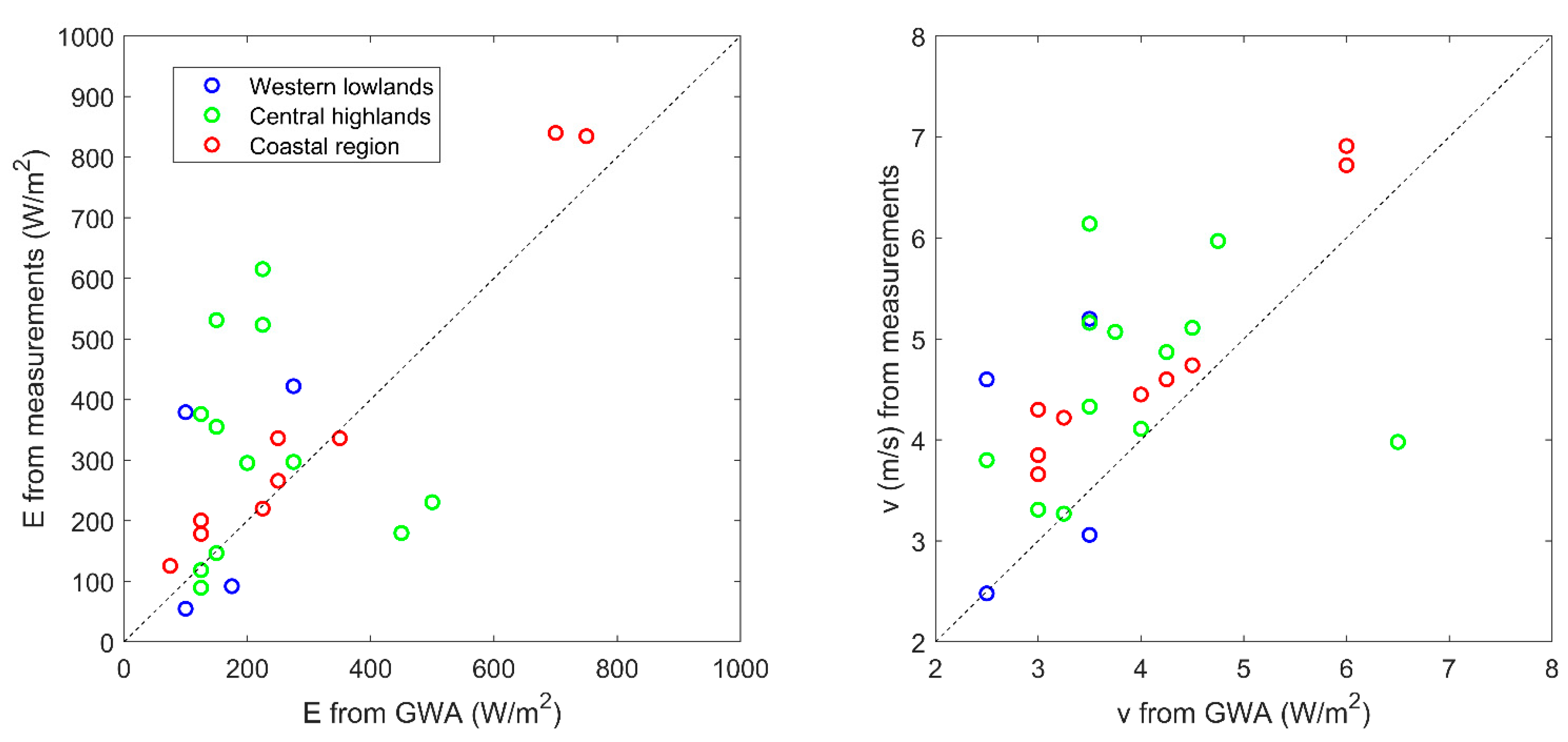
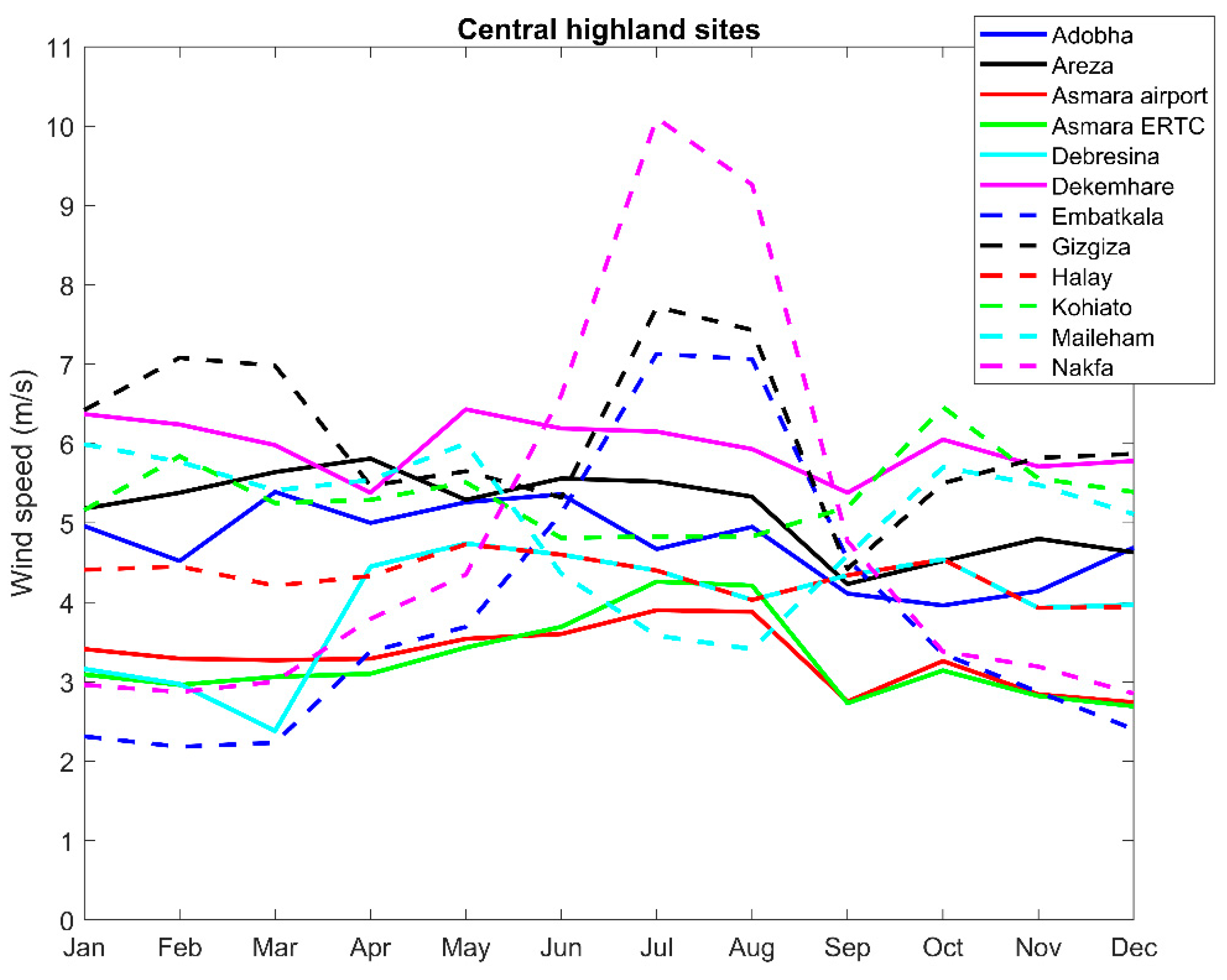
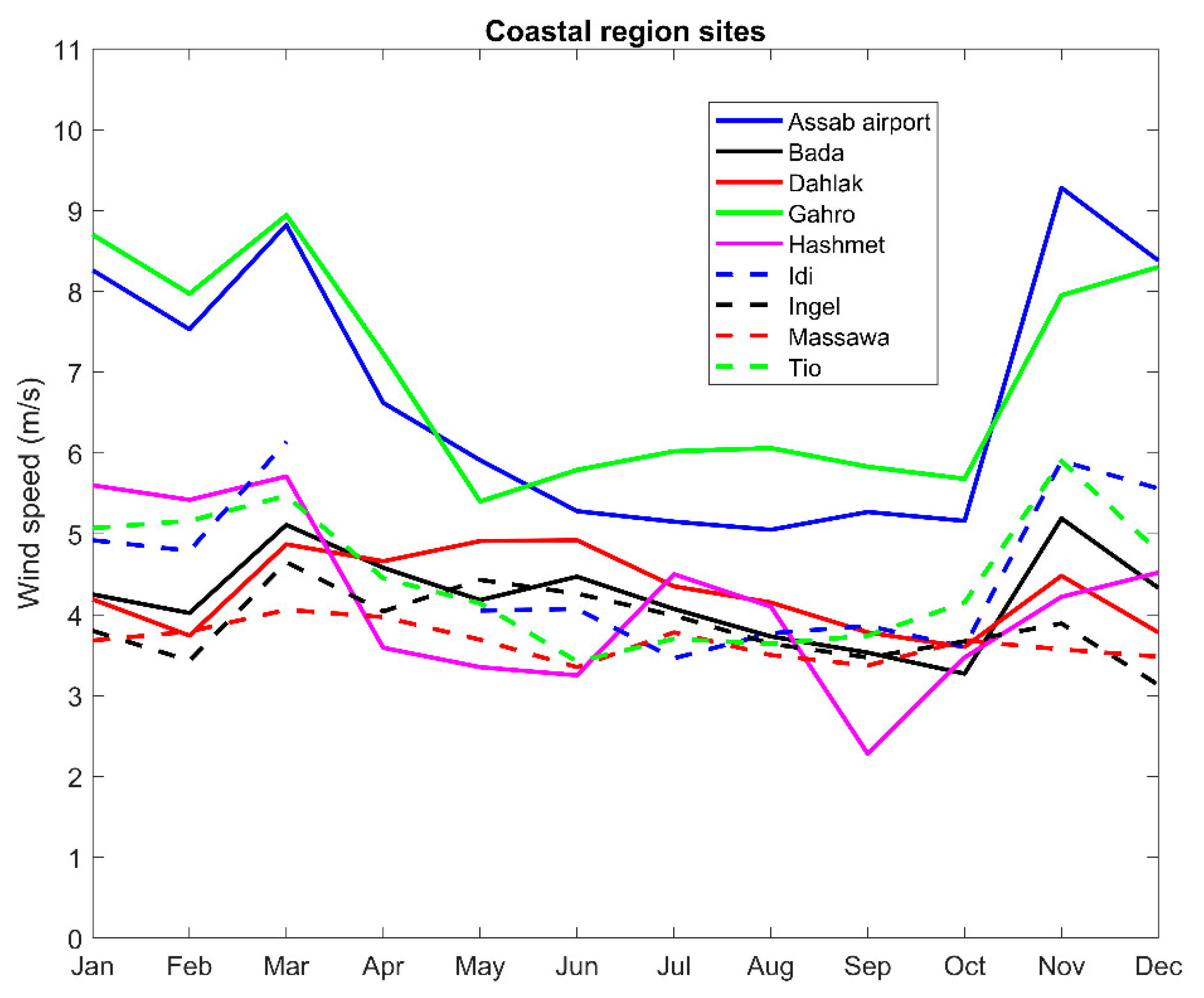

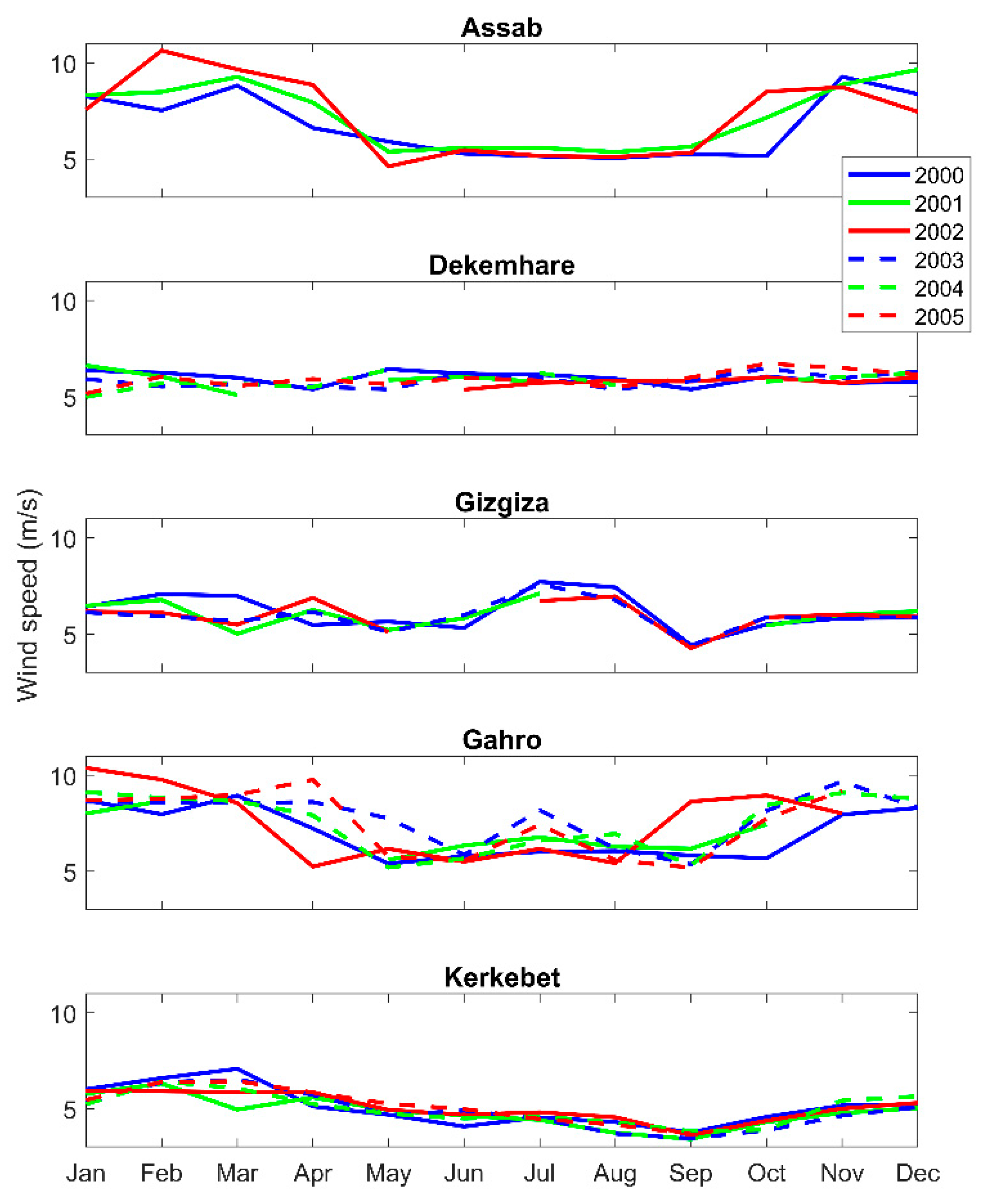
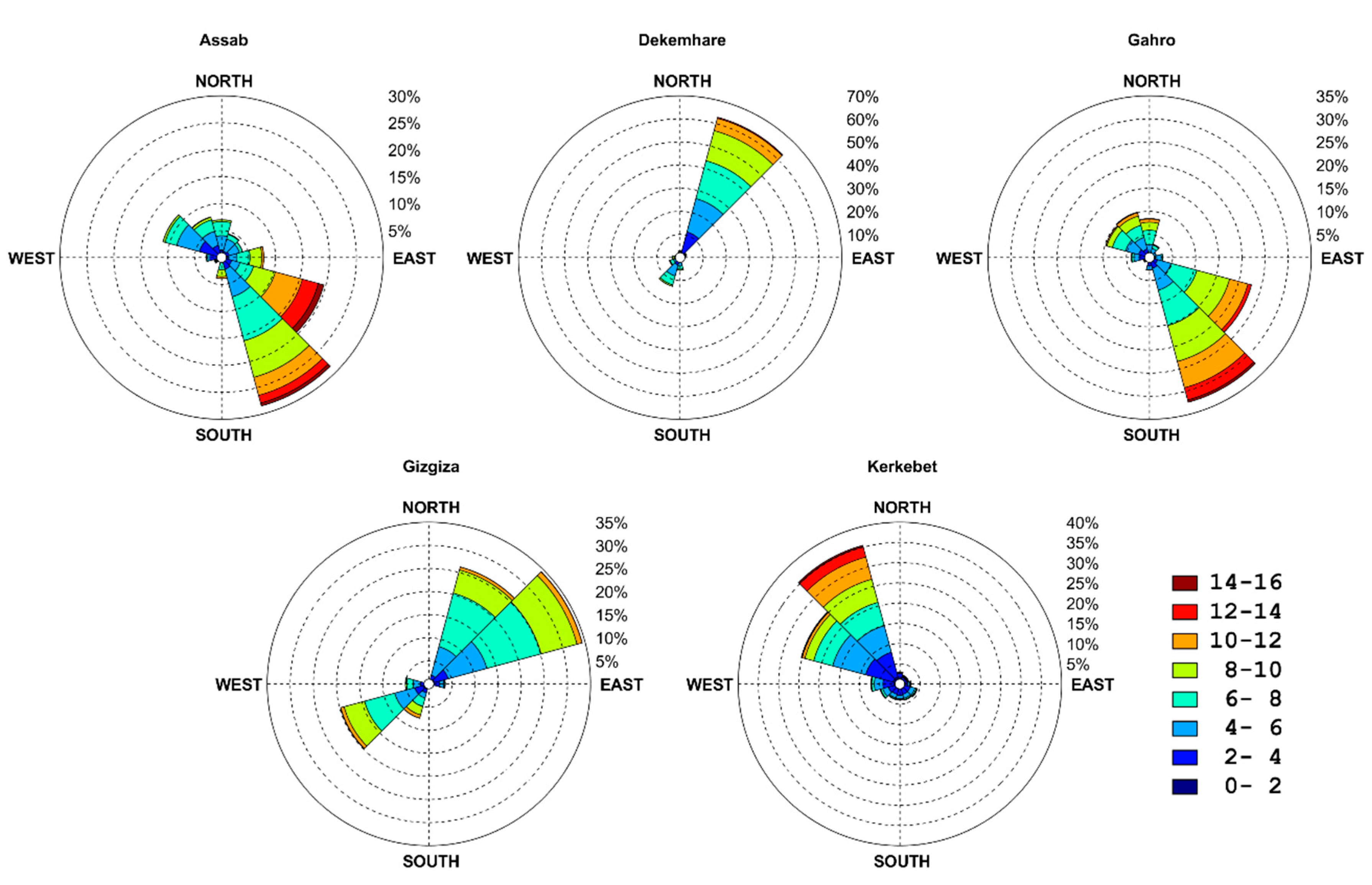

| Region | Map No. | Site | Lat | Long | Alt. (m) | E (W/m2) | ||
|---|---|---|---|---|---|---|---|---|
| Western lowland | 1 | Aligedir | 15°7.32′ N | 36°34.73′ E | 758 | 0.1 | 3.5 | 175 |
| 2 | Kerkebet | 16°3.53′ N | 37°25.89′ E | 450 | 0.01 | 3.5 | 275 | |
| 3 | Agordet | 15°33.12′ N | 37°52.55′ E | 633 | 0.05 | <2.5 | 100 | |
| 4 | Keren | 15°46.64′ N | 38°28.27′ E | 1400 | 0.25 | <2.5 | 100 | |
| Central highland | 5 | Adobha | 17°7.42′ N | 38°14.03′ E | 1870 | 0.05 | 4.0 | 450 |
| 6 | Nakfa | 16°39.00′ N | 38°24.00′ E | 2690 | 0.3 | 4.25 | 225 | |
| 7 | Gizgiza | 16°0.24′ N | 38°30.71′ E | 1180 | 0.05 | 3.5 | 225 | |
| 8 | Debresina | 15°45.28′ N | 38°42.29′ E | 2210 | 0.25 | 6.5 | 500 | |
| 9 | Embatkala | 15°23.83′ N | 39°4.37′ E | 1361 | 0.15 | <2.5 | 125 | |
| 10 | Asmara ERTC | 15°21.48′ N | 38°53.46′ E | 2230 | 0.05 | 3.25 | 125 | |
| 11 | Asmara Airport | 15°17.52′ N | 38°54.23′ E | 2325 | 0.15 | 3.0 | 125 | |
| 12 | Dekemhare | 15°4.82′ N | 39°3.12′ E | 2000 | 0.1 | 4.75 | 150 | |
| 13 | Halay | 15°1.19′ N | 39°19.18′ E | 2700 | 0.05 | 3.5 | 150 | |
| 14 | Kohiato | 14°53.97′ N | 39°24.58′ E | 2600 | 0.1 | 4.5 | 275 | |
| 15 | Areza | 14°54.79′ N | 38°33.83′ E | 2029 | 0.03 | 3.5 | 200 | |
| 16 | Maileham | 14°41.86′ N | 38°43.42′ E | 1980 | 0.05 | 3.75 | 150 | |
| Coastal region | 17 | Hashmet | 17°44.15′ N | 38°44.14′ E | 10 | 0.005 | 4.5 | 250 |
| 18 | Dahlak | 15°44.70′ N | 39°59.55′ E | 3 | 0.005 | 3.0 | 125 | |
| 19 | Massawa | 15°39.30′ N | 39°28.35′ E | 5 | 0.01 | 3.0 | 75 | |
| 20 | Ingel | 15°8.15′ N | 39°51.86′ E | 60 | 0.03 | 3.0 | 125 | |
| 21 | Tio | 14°40.75′ N | 40°57.70′ E | 0 | 0.005 | 4.0 | 225 | |
| 22 | Bada | 14°33.25′ N | 40°7.92′ E | −90 | 0.1 | 3.25 | 250 | |
| 23 | Idi | 13°55.78′ N | 41°41.27′ E | 10 | 0.01 | 4.25 | 350 | |
| 24 | Assab Airport | 13°1.60′ N | 42°38.94′ E | 0 | 0.03 | 6.0 | 700 | |
| 25 | Gahro | 12°47.47′ N | 43°4.24′ E | 30 | 0.03 | 6.0 | 750 |
| Region | Map No. | Site | E (W/m2) | std | Prev. Dir. | ||||
|---|---|---|---|---|---|---|---|---|---|
| Western lowland | 1 | Aligedir | 3.06 | 4.00 | 92 | 1.47 | 2.18 | 3.46 | N |
| 2 | Kerkebet | 5.20 | 422 | 3.16 | 1.70 | 5.81 | NW | ||
| 3 | Agordet | 2.48 | 55 | 1.33 | 1.71 | 2.76 | SW, NW | ||
| 4 | Keren | 4.60 | 379 | 2.26 | 2.1 | 5.2 | NE | ||
| Central highland | 5 | Adobha | 4.11 | 180 | 2.1 | 2.02 | 4.62 | NE | |
| 6 | Nakfa | 4.87 | 4.87 | 615 | 3.42 | 1.51 | 5.45 | SE, NW | |
| 7 | Gizgiza | 6.14 | 523 | 2.48 | 2.58 | 6.85 | NE | ||
| 8 | Debresina | 3.98 | 231 | 1.93 | 1.88 | 4.38 | NE | ||
| 9 | Embatkala | 3.80 | 376 | 2.6 | 1.26 | 4.11 | NE, SE | ||
| 10 | Asmara ERTC | 3.27 | 89 | 1.74 | 1.95 | 3.67 | NE | ||
| 11 | Asmara Airport | 3.31 | 4.89 | 118 | 1.75 | 1.91 | 3.72 | NE | |
| 12 | Dekemhare | 5.97 | 531 | 2.60 | 2.46 | 6.74 | NE | ||
| 13 | Halay | 4.33 | 147 | 1.63 | 2.85 | 4.86 | NE | ||
| 14 | Kohiato | 5.11 | 297 | 2.17 | 2.53 | 5.73 | NE, SE | ||
| 15 | Areza | 5.16 | 295 | 2.44 | 2.21 | 5.80 | E, NW | ||
| 16 | Maileham | 5.07 | 355 | 2.75 | 1.94 | 5.74 | NE, SW | ||
| Coastal region | 17 | Hashmet | 4.74 | 266 | 2.50 | 1.98 | 5.34 | NW, SE | |
| 18 | Dahlak | 4.30 | 200 | 2.26 | 1.97 | 4.85 | N | ||
| 19 | Massawa | 3.66 | 125 | 1.85 | 2.05 | 4.11 | NE | ||
| 20 | Ingel | 3.85 | 178 | 2.04 | 1.92 | 4.32 | N | ||
| 21 | Tio | 4.45 | 5.03 | 220 | 2.34 | 1.99 | 5.02 | NE, SE | |
| 22 | Bada | 4.22 | 336 | 2.59 | 1.71 | 4.70 | N | ||
| 23 | Idi | 4.60 | 336 | 2.92 | 1.60 | 5.13 | NE, SE | ||
| 24 | Assab Airport | 6.72 | 7.51 | 840 | 3.20 | 2.17 | 7.53 | SE | |
| 25 | Gahro | 6.91 | 834 | 2.97 | 2.50 | 7.80 | SE |
© 2020 by the authors. Licensee MDPI, Basel, Switzerland. This article is an open access article distributed under the terms and conditions of the Creative Commons Attribution (CC BY) license (http://creativecommons.org/licenses/by/4.0/).
Share and Cite
Negash, T.; Möllerström, E.; Ottermo, F. An Assessment of Wind Energy Potential for the Three Topographic Regions of Eritrea. Energies 2020, 13, 1846. https://doi.org/10.3390/en13071846
Negash T, Möllerström E, Ottermo F. An Assessment of Wind Energy Potential for the Three Topographic Regions of Eritrea. Energies. 2020; 13(7):1846. https://doi.org/10.3390/en13071846
Chicago/Turabian StyleNegash, Teklebrhan, Erik Möllerström, and Fredric Ottermo. 2020. "An Assessment of Wind Energy Potential for the Three Topographic Regions of Eritrea" Energies 13, no. 7: 1846. https://doi.org/10.3390/en13071846
APA StyleNegash, T., Möllerström, E., & Ottermo, F. (2020). An Assessment of Wind Energy Potential for the Three Topographic Regions of Eritrea. Energies, 13(7), 1846. https://doi.org/10.3390/en13071846





